Effective Talent Management Strategies in HRM: A Case Study of ASDA
VerifiedAdded on 2022/12/29
|18
|4186
|66
Report
AI Summary
This report delves into the critical role of talent management within Human Resource Management (HRM), specifically examining effective strategies for organizational success, using ASDA as a case study. The research begins with an overview of talent management, its significance in HRM, and the challenges faced during recruitment and selection. The report outlines the research objectives, questions, and methodology, including the use of a questionnaire based on the research onion model. The literature review covers the concept of talent management, its importance in HR operations, and problems encountered. The methodology section details the research approach, strategy, and data analysis techniques. The questionnaire results are presented and interpreted, followed by a reflection, conclusion, and recommendations. The research aims to provide insights into how talent management impacts HR operations, and to assess the challenges and provide recommendations for improvement.
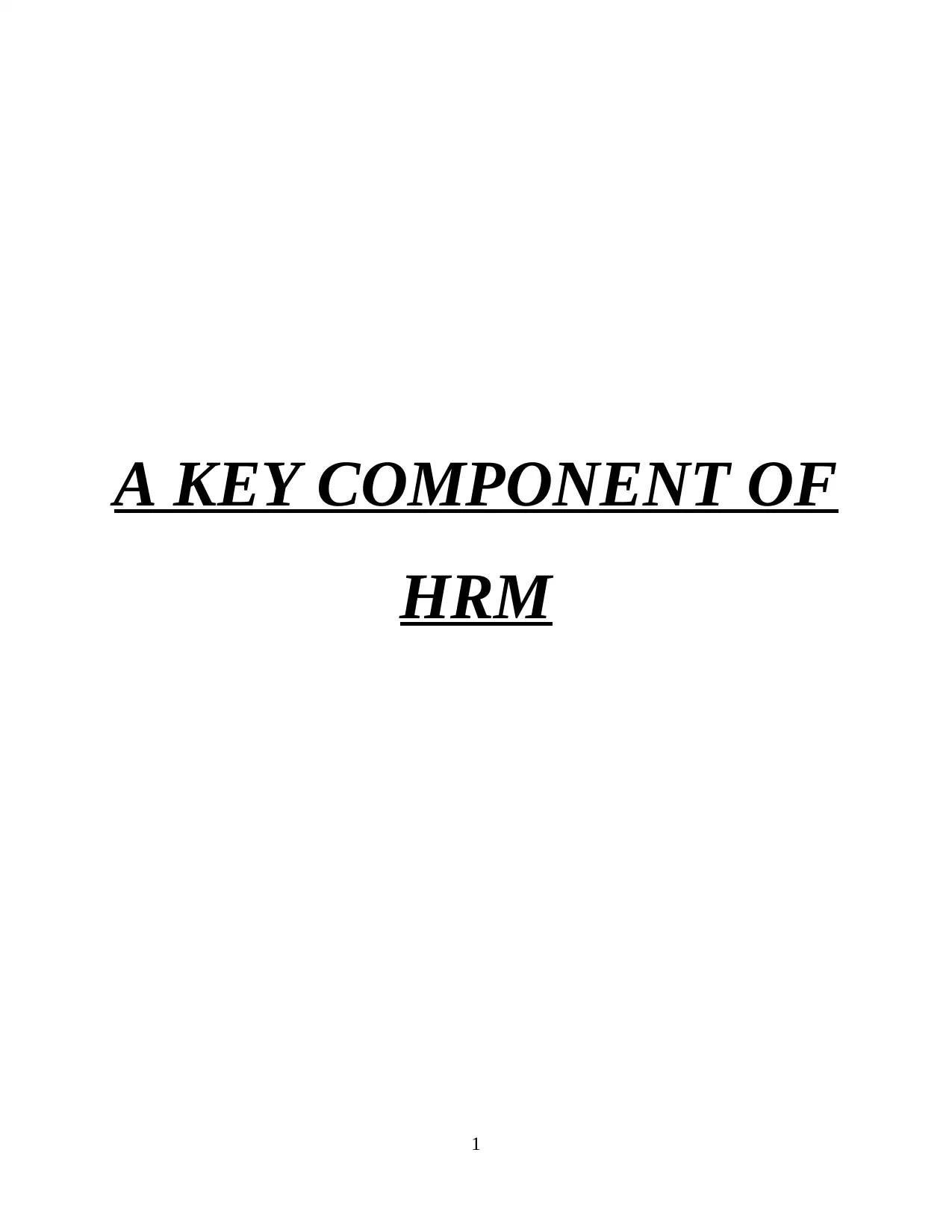
A KEY COMPONENT OF
HRM
1
HRM
1
Secure Best Marks with AI Grader
Need help grading? Try our AI Grader for instant feedback on your assignments.
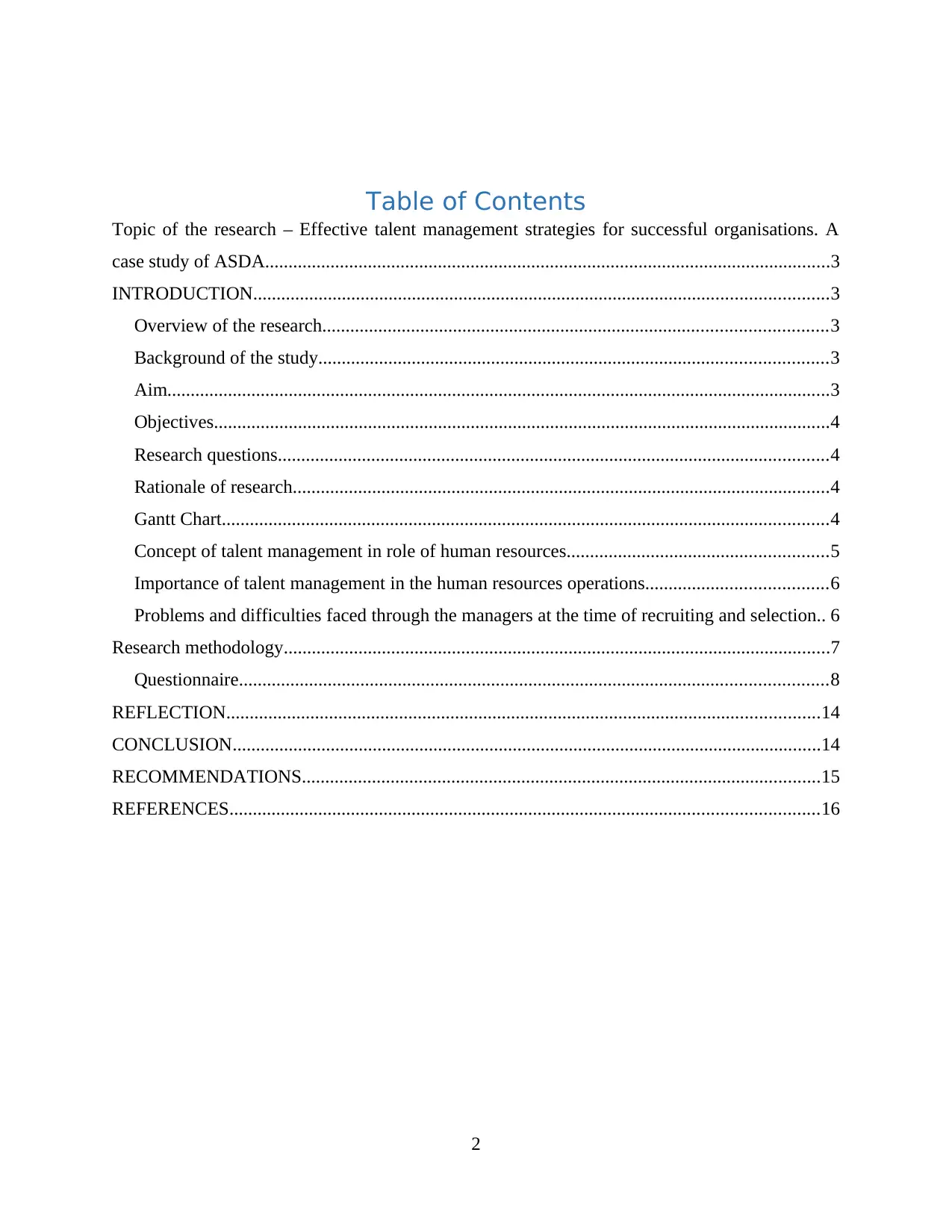
Table of Contents
Topic of the research – Effective talent management strategies for successful organisations. A
case study of ASDA.........................................................................................................................3
INTRODUCTION...........................................................................................................................3
Overview of the research............................................................................................................3
Background of the study.............................................................................................................3
Aim..............................................................................................................................................3
Objectives....................................................................................................................................4
Research questions......................................................................................................................4
Rationale of research...................................................................................................................4
Gantt Chart..................................................................................................................................4
Concept of talent management in role of human resources........................................................5
Importance of talent management in the human resources operations.......................................6
Problems and difficulties faced through the managers at the time of recruiting and selection.. 6
Research methodology.....................................................................................................................7
Questionnaire..............................................................................................................................8
REFLECTION...............................................................................................................................14
CONCLUSION..............................................................................................................................14
RECOMMENDATIONS...............................................................................................................15
REFERENCES..............................................................................................................................16
2
Topic of the research – Effective talent management strategies for successful organisations. A
case study of ASDA.........................................................................................................................3
INTRODUCTION...........................................................................................................................3
Overview of the research............................................................................................................3
Background of the study.............................................................................................................3
Aim..............................................................................................................................................3
Objectives....................................................................................................................................4
Research questions......................................................................................................................4
Rationale of research...................................................................................................................4
Gantt Chart..................................................................................................................................4
Concept of talent management in role of human resources........................................................5
Importance of talent management in the human resources operations.......................................6
Problems and difficulties faced through the managers at the time of recruiting and selection.. 6
Research methodology.....................................................................................................................7
Questionnaire..............................................................................................................................8
REFLECTION...............................................................................................................................14
CONCLUSION..............................................................................................................................14
RECOMMENDATIONS...............................................................................................................15
REFERENCES..............................................................................................................................16
2
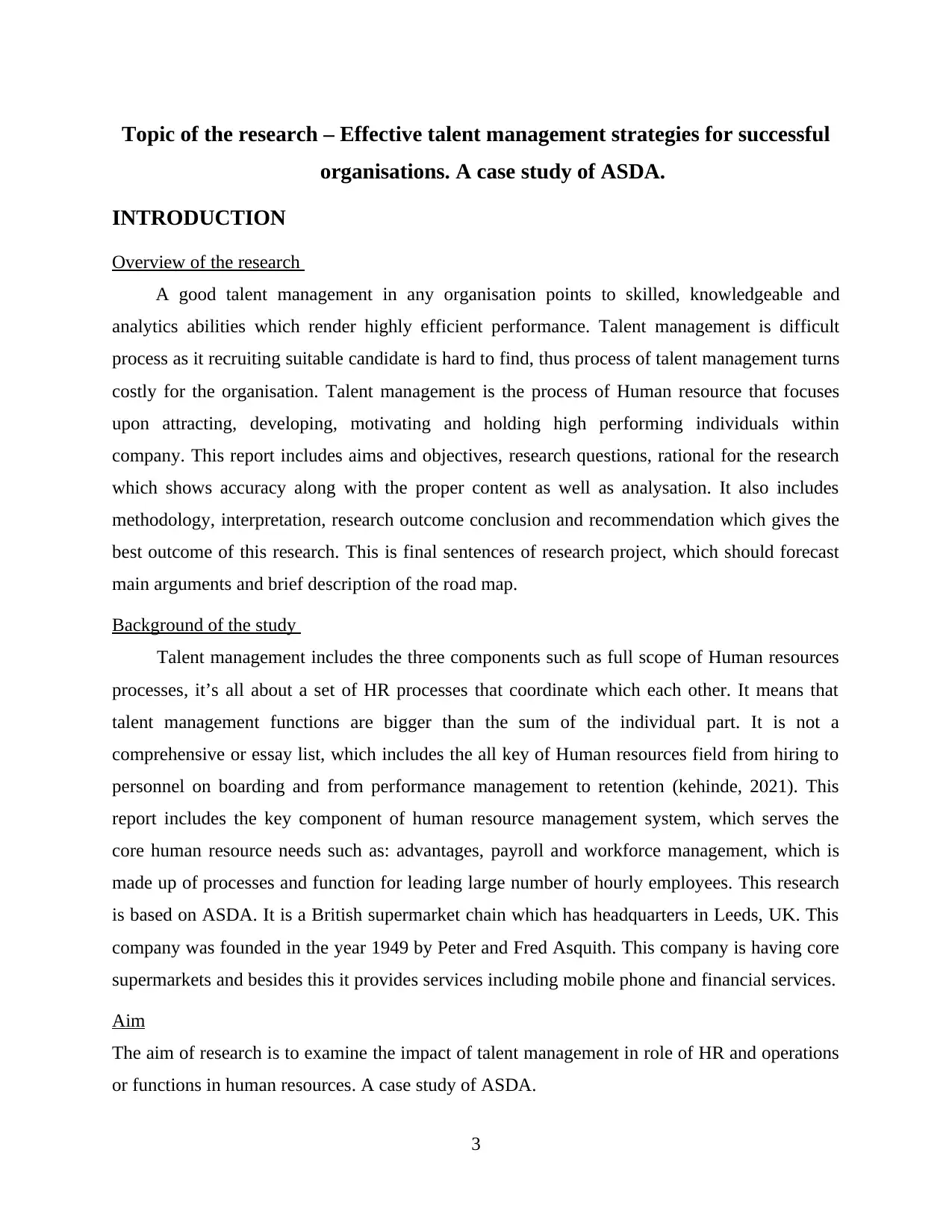
Topic of the research – Effective talent management strategies for successful
organisations. A case study of ASDA.
INTRODUCTION
Overview of the research
A good talent management in any organisation points to skilled, knowledgeable and
analytics abilities which render highly efficient performance. Talent management is difficult
process as it recruiting suitable candidate is hard to find, thus process of talent management turns
costly for the organisation. Talent management is the process of Human resource that focuses
upon attracting, developing, motivating and holding high performing individuals within
company. This report includes aims and objectives, research questions, rational for the research
which shows accuracy along with the proper content as well as analysation. It also includes
methodology, interpretation, research outcome conclusion and recommendation which gives the
best outcome of this research. This is final sentences of research project, which should forecast
main arguments and brief description of the road map.
Background of the study
Talent management includes the three components such as full scope of Human resources
processes, it’s all about a set of HR processes that coordinate which each other. It means that
talent management functions are bigger than the sum of the individual part. It is not a
comprehensive or essay list, which includes the all key of Human resources field from hiring to
personnel on boarding and from performance management to retention (kehinde, 2021). This
report includes the key component of human resource management system, which serves the
core human resource needs such as: advantages, payroll and workforce management, which is
made up of processes and function for leading large number of hourly employees. This research
is based on ASDA. It is a British supermarket chain which has headquarters in Leeds, UK. This
company was founded in the year 1949 by Peter and Fred Asquith. This company is having core
supermarkets and besides this it provides services including mobile phone and financial services.
Aim
The aim of research is to examine the impact of talent management in role of HR and operations
or functions in human resources. A case study of ASDA.
3
organisations. A case study of ASDA.
INTRODUCTION
Overview of the research
A good talent management in any organisation points to skilled, knowledgeable and
analytics abilities which render highly efficient performance. Talent management is difficult
process as it recruiting suitable candidate is hard to find, thus process of talent management turns
costly for the organisation. Talent management is the process of Human resource that focuses
upon attracting, developing, motivating and holding high performing individuals within
company. This report includes aims and objectives, research questions, rational for the research
which shows accuracy along with the proper content as well as analysation. It also includes
methodology, interpretation, research outcome conclusion and recommendation which gives the
best outcome of this research. This is final sentences of research project, which should forecast
main arguments and brief description of the road map.
Background of the study
Talent management includes the three components such as full scope of Human resources
processes, it’s all about a set of HR processes that coordinate which each other. It means that
talent management functions are bigger than the sum of the individual part. It is not a
comprehensive or essay list, which includes the all key of Human resources field from hiring to
personnel on boarding and from performance management to retention (kehinde, 2021). This
report includes the key component of human resource management system, which serves the
core human resource needs such as: advantages, payroll and workforce management, which is
made up of processes and function for leading large number of hourly employees. This research
is based on ASDA. It is a British supermarket chain which has headquarters in Leeds, UK. This
company was founded in the year 1949 by Peter and Fred Asquith. This company is having core
supermarkets and besides this it provides services including mobile phone and financial services.
Aim
The aim of research is to examine the impact of talent management in role of HR and operations
or functions in human resources. A case study of ASDA.
3
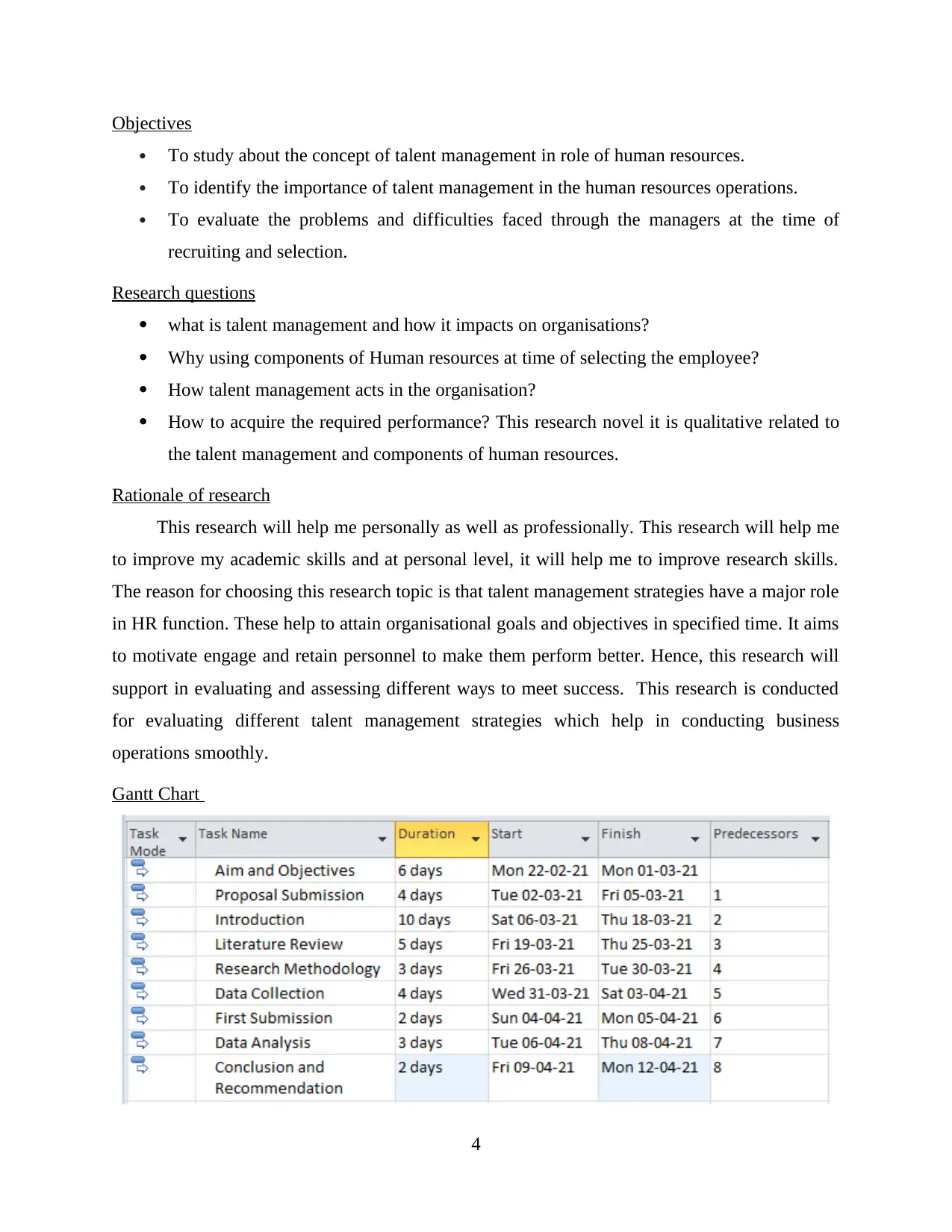
Objectives
To study about the concept of talent management in role of human resources.
To identify the importance of talent management in the human resources operations.
To evaluate the problems and difficulties faced through the managers at the time of
recruiting and selection.
Research questions
what is talent management and how it impacts on organisations?
Why using components of Human resources at time of selecting the employee?
How talent management acts in the organisation?
How to acquire the required performance? This research novel it is qualitative related to
the talent management and components of human resources.
Rationale of research
This research will help me personally as well as professionally. This research will help me
to improve my academic skills and at personal level, it will help me to improve research skills.
The reason for choosing this research topic is that talent management strategies have a major role
in HR function. These help to attain organisational goals and objectives in specified time. It aims
to motivate engage and retain personnel to make them perform better. Hence, this research will
support in evaluating and assessing different ways to meet success. This research is conducted
for evaluating different talent management strategies which help in conducting business
operations smoothly.
Gantt Chart
4
To study about the concept of talent management in role of human resources.
To identify the importance of talent management in the human resources operations.
To evaluate the problems and difficulties faced through the managers at the time of
recruiting and selection.
Research questions
what is talent management and how it impacts on organisations?
Why using components of Human resources at time of selecting the employee?
How talent management acts in the organisation?
How to acquire the required performance? This research novel it is qualitative related to
the talent management and components of human resources.
Rationale of research
This research will help me personally as well as professionally. This research will help me
to improve my academic skills and at personal level, it will help me to improve research skills.
The reason for choosing this research topic is that talent management strategies have a major role
in HR function. These help to attain organisational goals and objectives in specified time. It aims
to motivate engage and retain personnel to make them perform better. Hence, this research will
support in evaluating and assessing different ways to meet success. This research is conducted
for evaluating different talent management strategies which help in conducting business
operations smoothly.
Gantt Chart
4
Secure Best Marks with AI Grader
Need help grading? Try our AI Grader for instant feedback on your assignments.
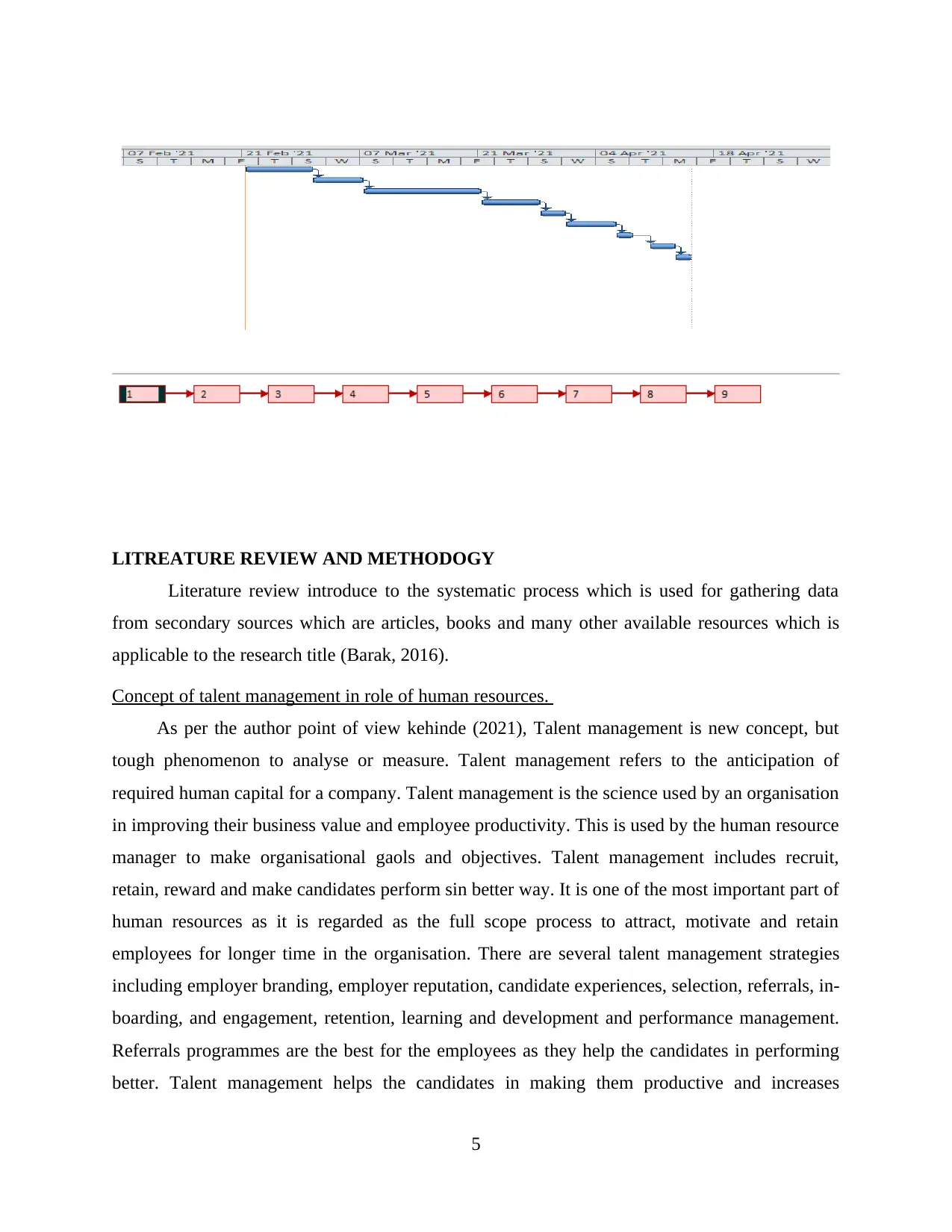
LITREATURE REVIEW AND METHODOGY
Literature review introduce to the systematic process which is used for gathering data
from secondary sources which are articles, books and many other available resources which is
applicable to the research title (Barak, 2016).
Concept of talent management in role of human resources.
As per the author point of view kehinde (2021), Talent management is new concept, but
tough phenomenon to analyse or measure. Talent management refers to the anticipation of
required human capital for a company. Talent management is the science used by an organisation
in improving their business value and employee productivity. This is used by the human resource
manager to make organisational gaols and objectives. Talent management includes recruit,
retain, reward and make candidates perform sin better way. It is one of the most important part of
human resources as it is regarded as the full scope process to attract, motivate and retain
employees for longer time in the organisation. There are several talent management strategies
including employer branding, employer reputation, candidate experiences, selection, referrals, in-
boarding, and engagement, retention, learning and development and performance management.
Referrals programmes are the best for the employees as they help the candidates in performing
better. Talent management helps the candidates in making them productive and increases
5
Literature review introduce to the systematic process which is used for gathering data
from secondary sources which are articles, books and many other available resources which is
applicable to the research title (Barak, 2016).
Concept of talent management in role of human resources.
As per the author point of view kehinde (2021), Talent management is new concept, but
tough phenomenon to analyse or measure. Talent management refers to the anticipation of
required human capital for a company. Talent management is the science used by an organisation
in improving their business value and employee productivity. This is used by the human resource
manager to make organisational gaols and objectives. Talent management includes recruit,
retain, reward and make candidates perform sin better way. It is one of the most important part of
human resources as it is regarded as the full scope process to attract, motivate and retain
employees for longer time in the organisation. There are several talent management strategies
including employer branding, employer reputation, candidate experiences, selection, referrals, in-
boarding, and engagement, retention, learning and development and performance management.
Referrals programmes are the best for the employees as they help the candidates in performing
better. Talent management helps the candidates in making them productive and increases
5
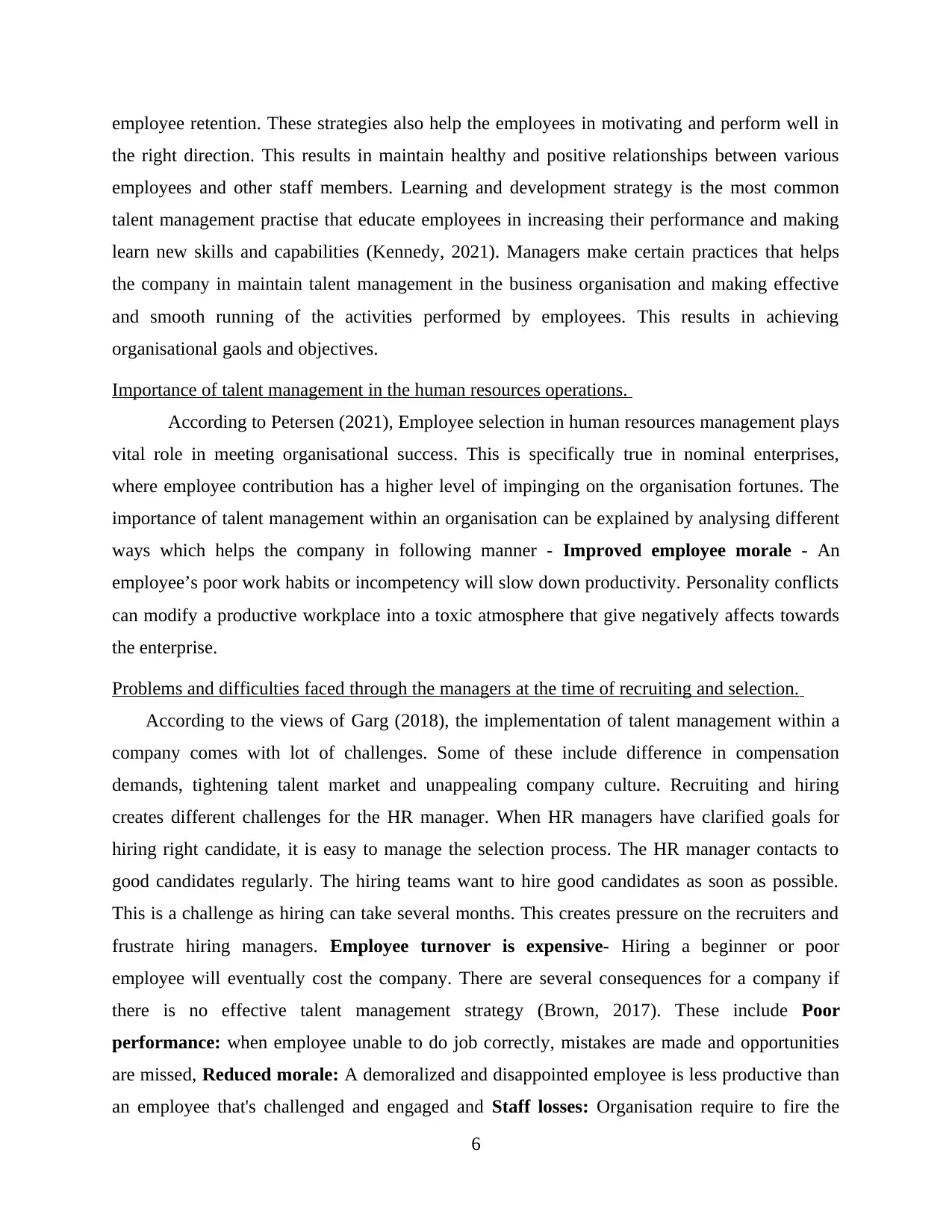
employee retention. These strategies also help the employees in motivating and perform well in
the right direction. This results in maintain healthy and positive relationships between various
employees and other staff members. Learning and development strategy is the most common
talent management practise that educate employees in increasing their performance and making
learn new skills and capabilities (Kennedy, 2021). Managers make certain practices that helps
the company in maintain talent management in the business organisation and making effective
and smooth running of the activities performed by employees. This results in achieving
organisational gaols and objectives.
Importance of talent management in the human resources operations.
According to Petersen (2021), Employee selection in human resources management plays
vital role in meeting organisational success. This is specifically true in nominal enterprises,
where employee contribution has a higher level of impinging on the organisation fortunes. The
importance of talent management within an organisation can be explained by analysing different
ways which helps the company in following manner - Improved employee morale - An
employee’s poor work habits or incompetency will slow down productivity. Personality conflicts
can modify a productive workplace into a toxic atmosphere that give negatively affects towards
the enterprise.
Problems and difficulties faced through the managers at the time of recruiting and selection.
According to the views of Garg (2018), the implementation of talent management within a
company comes with lot of challenges. Some of these include difference in compensation
demands, tightening talent market and unappealing company culture. Recruiting and hiring
creates different challenges for the HR manager. When HR managers have clarified goals for
hiring right candidate, it is easy to manage the selection process. The HR manager contacts to
good candidates regularly. The hiring teams want to hire good candidates as soon as possible.
This is a challenge as hiring can take several months. This creates pressure on the recruiters and
frustrate hiring managers. Employee turnover is expensive- Hiring a beginner or poor
employee will eventually cost the company. There are several consequences for a company if
there is no effective talent management strategy (Brown, 2017). These include Poor
performance: when employee unable to do job correctly, mistakes are made and opportunities
are missed, Reduced morale: A demoralized and disappointed employee is less productive than
an employee that's challenged and engaged and Staff losses: Organisation require to fire the
6
the right direction. This results in maintain healthy and positive relationships between various
employees and other staff members. Learning and development strategy is the most common
talent management practise that educate employees in increasing their performance and making
learn new skills and capabilities (Kennedy, 2021). Managers make certain practices that helps
the company in maintain talent management in the business organisation and making effective
and smooth running of the activities performed by employees. This results in achieving
organisational gaols and objectives.
Importance of talent management in the human resources operations.
According to Petersen (2021), Employee selection in human resources management plays
vital role in meeting organisational success. This is specifically true in nominal enterprises,
where employee contribution has a higher level of impinging on the organisation fortunes. The
importance of talent management within an organisation can be explained by analysing different
ways which helps the company in following manner - Improved employee morale - An
employee’s poor work habits or incompetency will slow down productivity. Personality conflicts
can modify a productive workplace into a toxic atmosphere that give negatively affects towards
the enterprise.
Problems and difficulties faced through the managers at the time of recruiting and selection.
According to the views of Garg (2018), the implementation of talent management within a
company comes with lot of challenges. Some of these include difference in compensation
demands, tightening talent market and unappealing company culture. Recruiting and hiring
creates different challenges for the HR manager. When HR managers have clarified goals for
hiring right candidate, it is easy to manage the selection process. The HR manager contacts to
good candidates regularly. The hiring teams want to hire good candidates as soon as possible.
This is a challenge as hiring can take several months. This creates pressure on the recruiters and
frustrate hiring managers. Employee turnover is expensive- Hiring a beginner or poor
employee will eventually cost the company. There are several consequences for a company if
there is no effective talent management strategy (Brown, 2017). These include Poor
performance: when employee unable to do job correctly, mistakes are made and opportunities
are missed, Reduced morale: A demoralized and disappointed employee is less productive than
an employee that's challenged and engaged and Staff losses: Organisation require to fire the
6
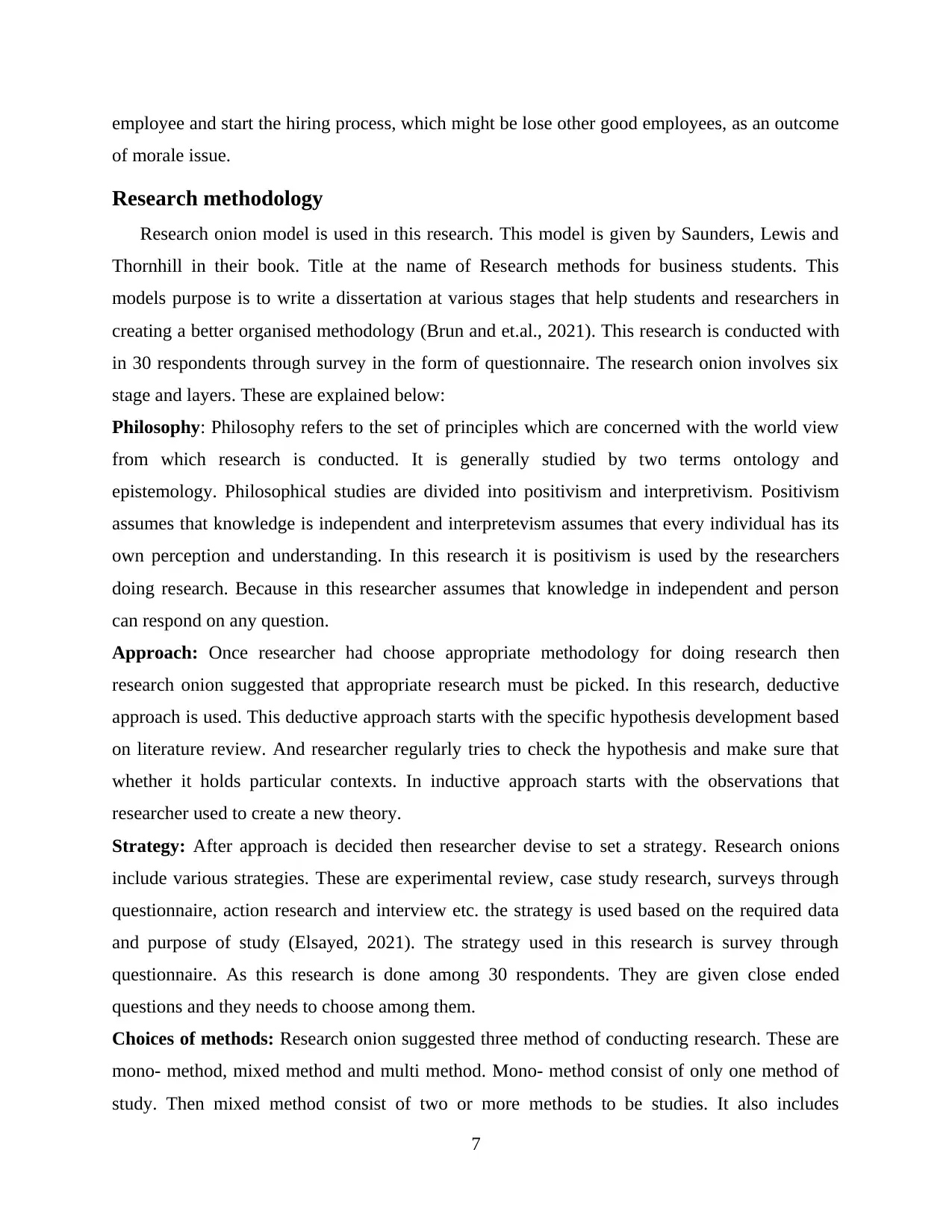
employee and start the hiring process, which might be lose other good employees, as an outcome
of morale issue.
Research methodology
Research onion model is used in this research. This model is given by Saunders, Lewis and
Thornhill in their book. Title at the name of Research methods for business students. This
models purpose is to write a dissertation at various stages that help students and researchers in
creating a better organised methodology (Brun and et.al., 2021). This research is conducted with
in 30 respondents through survey in the form of questionnaire. The research onion involves six
stage and layers. These are explained below:
Philosophy: Philosophy refers to the set of principles which are concerned with the world view
from which research is conducted. It is generally studied by two terms ontology and
epistemology. Philosophical studies are divided into positivism and interpretivism. Positivism
assumes that knowledge is independent and interpretevism assumes that every individual has its
own perception and understanding. In this research it is positivism is used by the researchers
doing research. Because in this researcher assumes that knowledge in independent and person
can respond on any question.
Approach: Once researcher had choose appropriate methodology for doing research then
research onion suggested that appropriate research must be picked. In this research, deductive
approach is used. This deductive approach starts with the specific hypothesis development based
on literature review. And researcher regularly tries to check the hypothesis and make sure that
whether it holds particular contexts. In inductive approach starts with the observations that
researcher used to create a new theory.
Strategy: After approach is decided then researcher devise to set a strategy. Research onions
include various strategies. These are experimental review, case study research, surveys through
questionnaire, action research and interview etc. the strategy is used based on the required data
and purpose of study (Elsayed, 2021). The strategy used in this research is survey through
questionnaire. As this research is done among 30 respondents. They are given close ended
questions and they needs to choose among them.
Choices of methods: Research onion suggested three method of conducting research. These are
mono- method, mixed method and multi method. Mono- method consist of only one method of
study. Then mixed method consist of two or more methods to be studies. It also includes
7
of morale issue.
Research methodology
Research onion model is used in this research. This model is given by Saunders, Lewis and
Thornhill in their book. Title at the name of Research methods for business students. This
models purpose is to write a dissertation at various stages that help students and researchers in
creating a better organised methodology (Brun and et.al., 2021). This research is conducted with
in 30 respondents through survey in the form of questionnaire. The research onion involves six
stage and layers. These are explained below:
Philosophy: Philosophy refers to the set of principles which are concerned with the world view
from which research is conducted. It is generally studied by two terms ontology and
epistemology. Philosophical studies are divided into positivism and interpretivism. Positivism
assumes that knowledge is independent and interpretevism assumes that every individual has its
own perception and understanding. In this research it is positivism is used by the researchers
doing research. Because in this researcher assumes that knowledge in independent and person
can respond on any question.
Approach: Once researcher had choose appropriate methodology for doing research then
research onion suggested that appropriate research must be picked. In this research, deductive
approach is used. This deductive approach starts with the specific hypothesis development based
on literature review. And researcher regularly tries to check the hypothesis and make sure that
whether it holds particular contexts. In inductive approach starts with the observations that
researcher used to create a new theory.
Strategy: After approach is decided then researcher devise to set a strategy. Research onions
include various strategies. These are experimental review, case study research, surveys through
questionnaire, action research and interview etc. the strategy is used based on the required data
and purpose of study (Elsayed, 2021). The strategy used in this research is survey through
questionnaire. As this research is done among 30 respondents. They are given close ended
questions and they needs to choose among them.
Choices of methods: Research onion suggested three method of conducting research. These are
mono- method, mixed method and multi method. Mono- method consist of only one method of
study. Then mixed method consist of two or more methods to be studies. It also includes
7
Paraphrase This Document
Need a fresh take? Get an instant paraphrase of this document with our AI Paraphraser
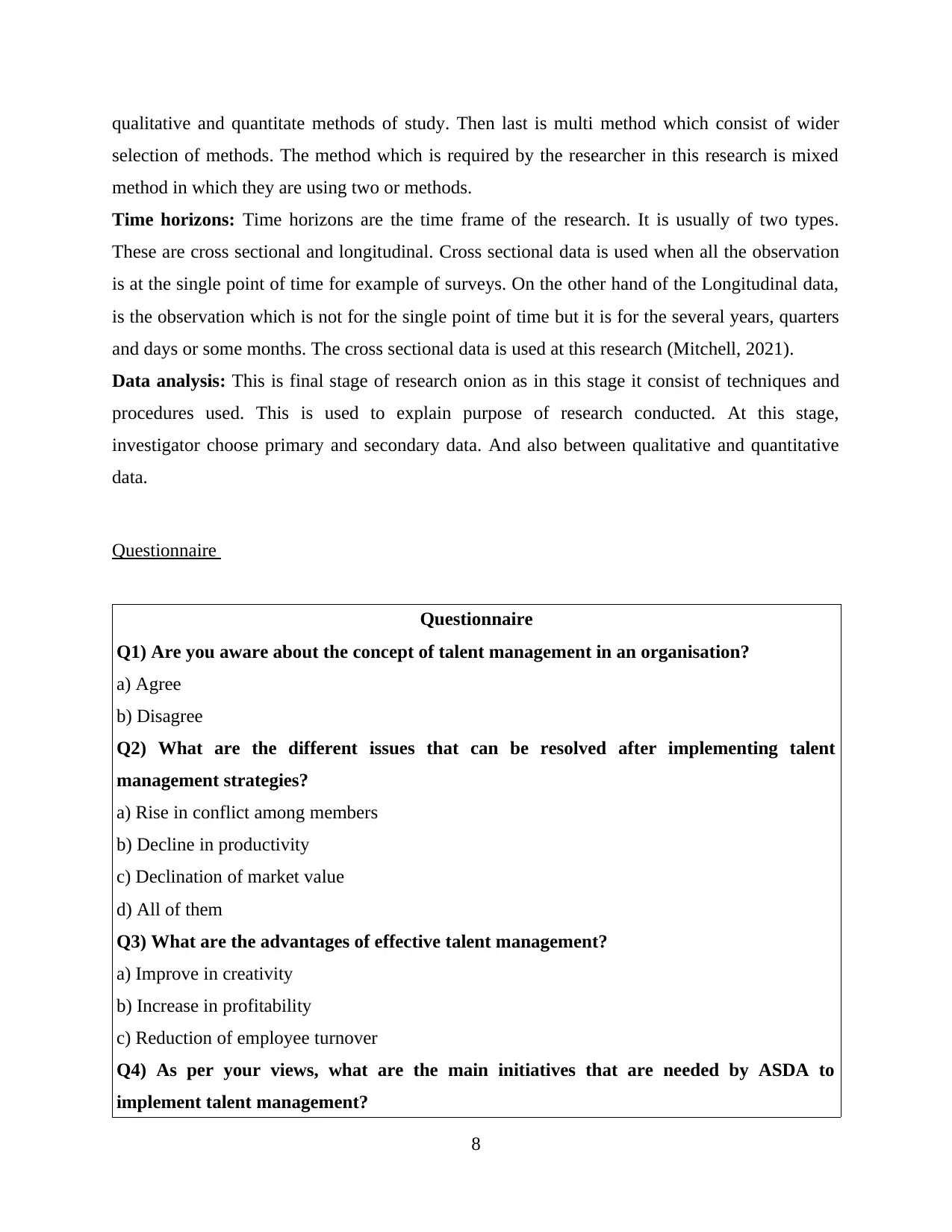
qualitative and quantitate methods of study. Then last is multi method which consist of wider
selection of methods. The method which is required by the researcher in this research is mixed
method in which they are using two or methods.
Time horizons: Time horizons are the time frame of the research. It is usually of two types.
These are cross sectional and longitudinal. Cross sectional data is used when all the observation
is at the single point of time for example of surveys. On the other hand of the Longitudinal data,
is the observation which is not for the single point of time but it is for the several years, quarters
and days or some months. The cross sectional data is used at this research (Mitchell, 2021).
Data analysis: This is final stage of research onion as in this stage it consist of techniques and
procedures used. This is used to explain purpose of research conducted. At this stage,
investigator choose primary and secondary data. And also between qualitative and quantitative
data.
Questionnaire
Questionnaire
Q1) Are you aware about the concept of talent management in an organisation?
a) Agree
b) Disagree
Q2) What are the different issues that can be resolved after implementing talent
management strategies?
a) Rise in conflict among members
b) Decline in productivity
c) Declination of market value
d) All of them
Q3) What are the advantages of effective talent management?
a) Improve in creativity
b) Increase in profitability
c) Reduction of employee turnover
Q4) As per your views, what are the main initiatives that are needed by ASDA to
implement talent management?
8
selection of methods. The method which is required by the researcher in this research is mixed
method in which they are using two or methods.
Time horizons: Time horizons are the time frame of the research. It is usually of two types.
These are cross sectional and longitudinal. Cross sectional data is used when all the observation
is at the single point of time for example of surveys. On the other hand of the Longitudinal data,
is the observation which is not for the single point of time but it is for the several years, quarters
and days or some months. The cross sectional data is used at this research (Mitchell, 2021).
Data analysis: This is final stage of research onion as in this stage it consist of techniques and
procedures used. This is used to explain purpose of research conducted. At this stage,
investigator choose primary and secondary data. And also between qualitative and quantitative
data.
Questionnaire
Questionnaire
Q1) Are you aware about the concept of talent management in an organisation?
a) Agree
b) Disagree
Q2) What are the different issues that can be resolved after implementing talent
management strategies?
a) Rise in conflict among members
b) Decline in productivity
c) Declination of market value
d) All of them
Q3) What are the advantages of effective talent management?
a) Improve in creativity
b) Increase in profitability
c) Reduction of employee turnover
Q4) As per your views, what are the main initiatives that are needed by ASDA to
implement talent management?
8
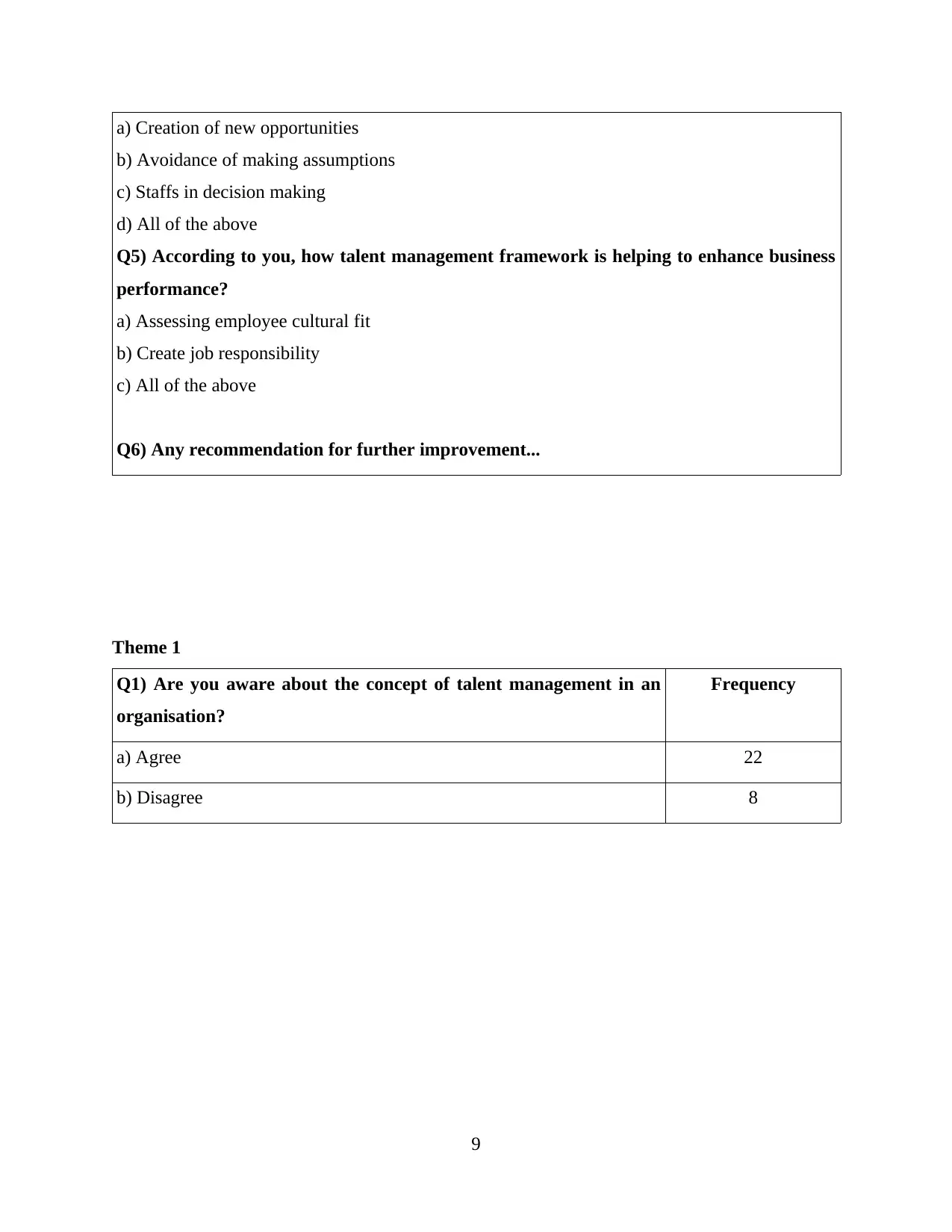
a) Creation of new opportunities
b) Avoidance of making assumptions
c) Staffs in decision making
d) All of the above
Q5) According to you, how talent management framework is helping to enhance business
performance?
a) Assessing employee cultural fit
b) Create job responsibility
c) All of the above
Q6) Any recommendation for further improvement...
Theme 1
Q1) Are you aware about the concept of talent management in an
organisation?
Frequency
a) Agree 22
b) Disagree 8
9
b) Avoidance of making assumptions
c) Staffs in decision making
d) All of the above
Q5) According to you, how talent management framework is helping to enhance business
performance?
a) Assessing employee cultural fit
b) Create job responsibility
c) All of the above
Q6) Any recommendation for further improvement...
Theme 1
Q1) Are you aware about the concept of talent management in an
organisation?
Frequency
a) Agree 22
b) Disagree 8
9
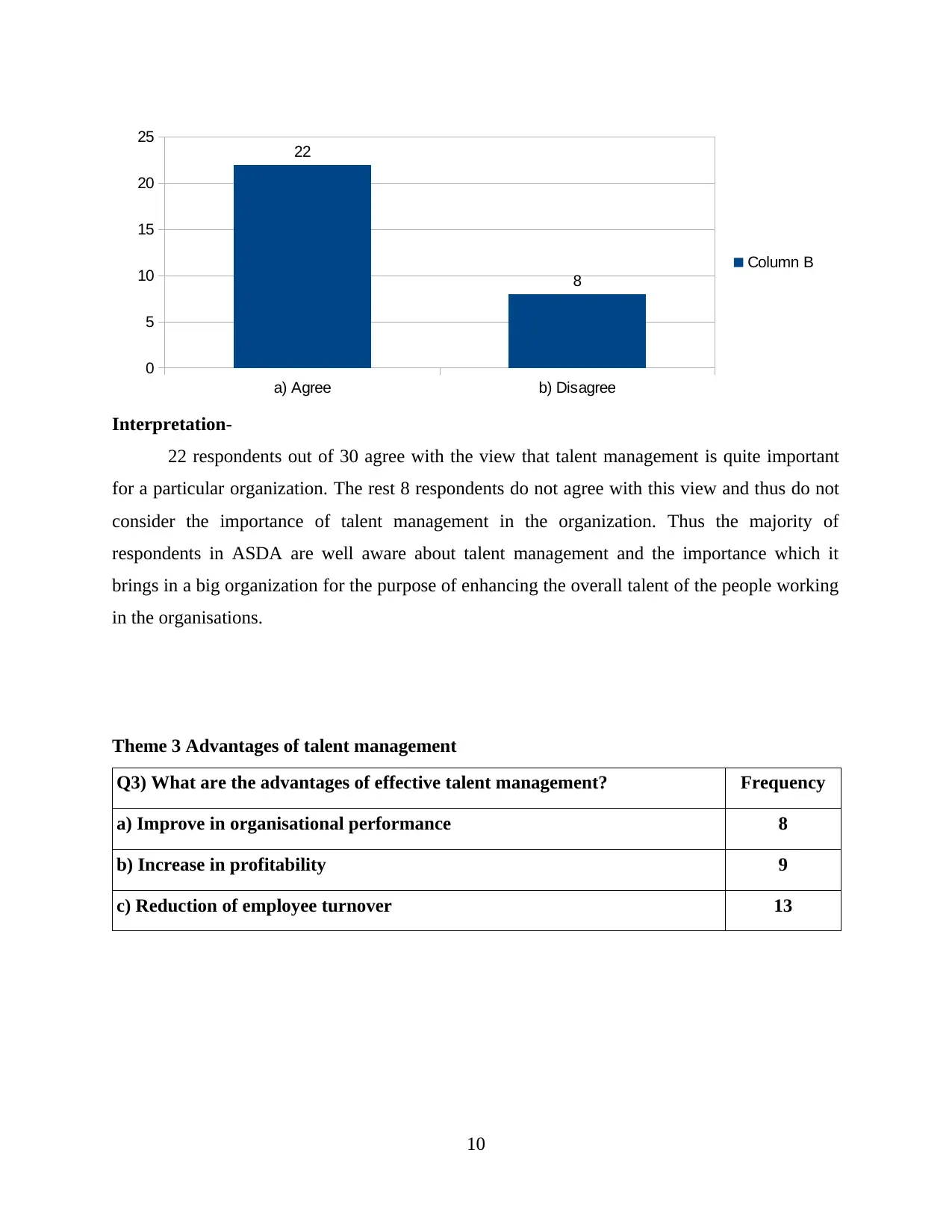
Interpretation-
22 respondents out of 30 agree with the view that talent management is quite important
for a particular organization. The rest 8 respondents do not agree with this view and thus do not
consider the importance of talent management in the organization. Thus the majority of
respondents in ASDA are well aware about talent management and the importance which it
brings in a big organization for the purpose of enhancing the overall talent of the people working
in the organisations.
Theme 3 Advantages of talent management
Q3) What are the advantages of effective talent management? Frequency
a) Improve in organisational performance 8
b) Increase in profitability 9
c) Reduction of employee turnover 13
10
a) Agree b) Disagree
0
5
10
15
20
25 22
8
Column B
22 respondents out of 30 agree with the view that talent management is quite important
for a particular organization. The rest 8 respondents do not agree with this view and thus do not
consider the importance of talent management in the organization. Thus the majority of
respondents in ASDA are well aware about talent management and the importance which it
brings in a big organization for the purpose of enhancing the overall talent of the people working
in the organisations.
Theme 3 Advantages of talent management
Q3) What are the advantages of effective talent management? Frequency
a) Improve in organisational performance 8
b) Increase in profitability 9
c) Reduction of employee turnover 13
10
a) Agree b) Disagree
0
5
10
15
20
25 22
8
Column B
Secure Best Marks with AI Grader
Need help grading? Try our AI Grader for instant feedback on your assignments.
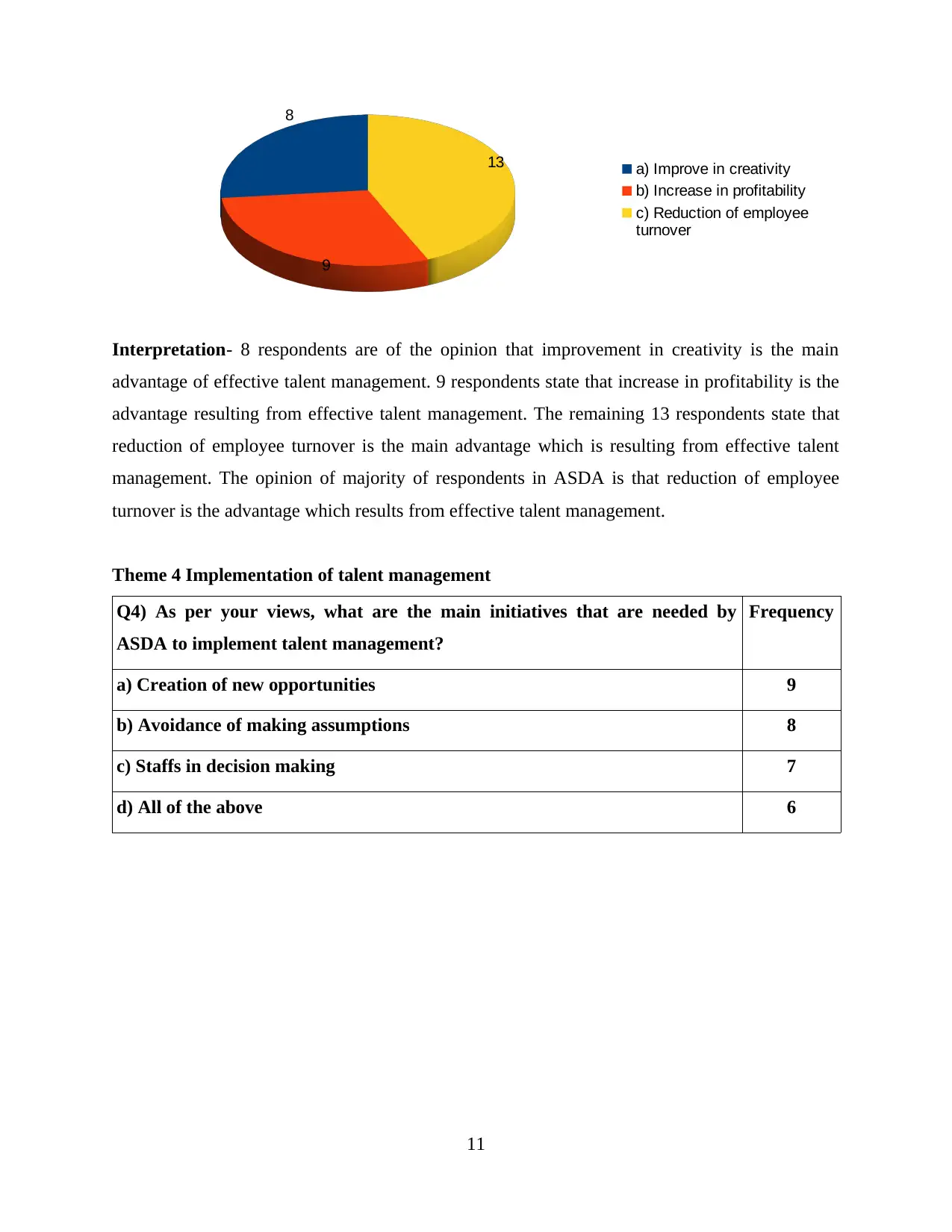
Interpretation- 8 respondents are of the opinion that improvement in creativity is the main
advantage of effective talent management. 9 respondents state that increase in profitability is the
advantage resulting from effective talent management. The remaining 13 respondents state that
reduction of employee turnover is the main advantage which is resulting from effective talent
management. The opinion of majority of respondents in ASDA is that reduction of employee
turnover is the advantage which results from effective talent management.
Theme 4 Implementation of talent management
Q4) As per your views, what are the main initiatives that are needed by
ASDA to implement talent management?
Frequency
a) Creation of new opportunities 9
b) Avoidance of making assumptions 8
c) Staffs in decision making 7
d) All of the above 6
11
8
9
13 a) Improve in creativity
b) Increase in profitability
c) Reduction of employee
turnover
advantage of effective talent management. 9 respondents state that increase in profitability is the
advantage resulting from effective talent management. The remaining 13 respondents state that
reduction of employee turnover is the main advantage which is resulting from effective talent
management. The opinion of majority of respondents in ASDA is that reduction of employee
turnover is the advantage which results from effective talent management.
Theme 4 Implementation of talent management
Q4) As per your views, what are the main initiatives that are needed by
ASDA to implement talent management?
Frequency
a) Creation of new opportunities 9
b) Avoidance of making assumptions 8
c) Staffs in decision making 7
d) All of the above 6
11
8
9
13 a) Improve in creativity
b) Increase in profitability
c) Reduction of employee
turnover
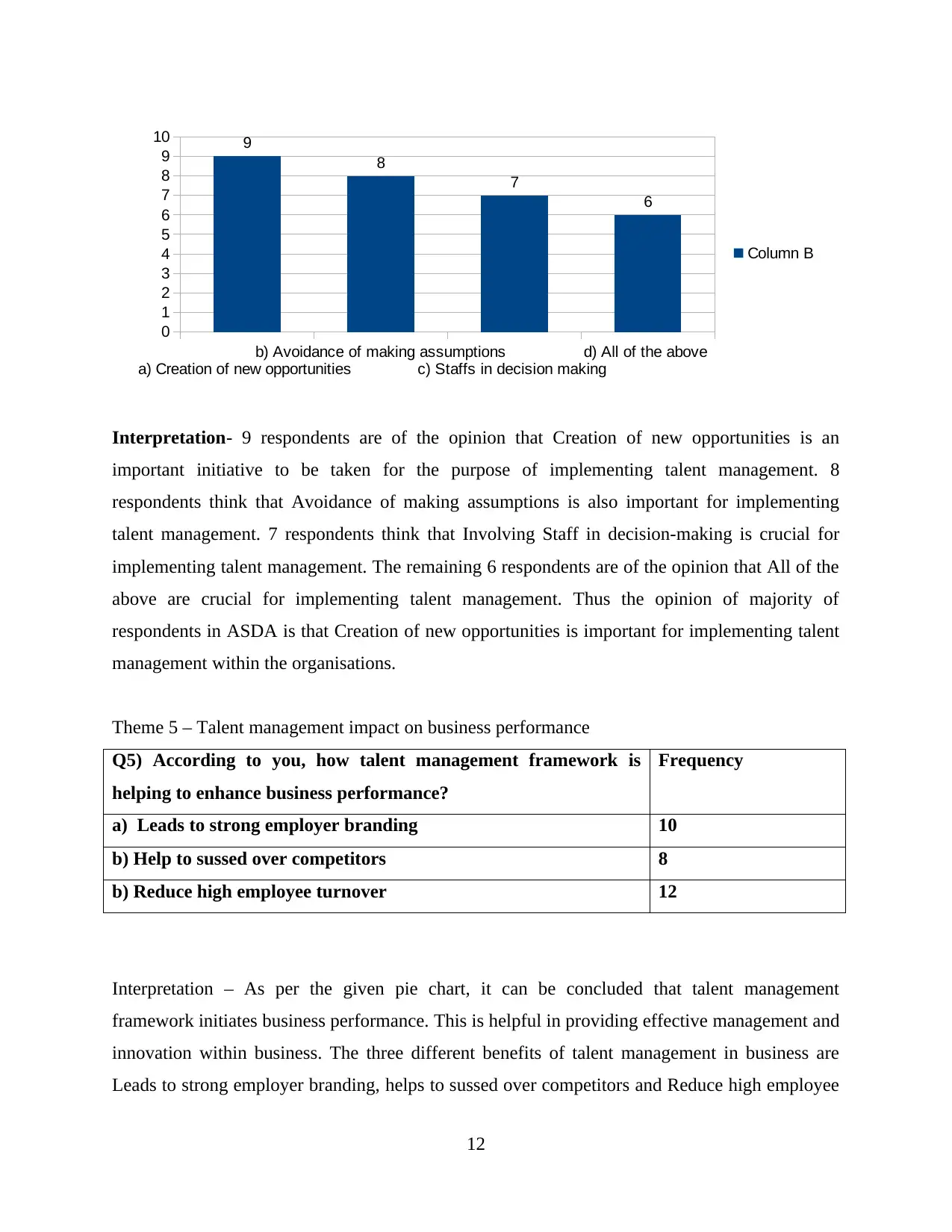
Interpretation- 9 respondents are of the opinion that Creation of new opportunities is an
important initiative to be taken for the purpose of implementing talent management. 8
respondents think that Avoidance of making assumptions is also important for implementing
talent management. 7 respondents think that Involving Staff in decision-making is crucial for
implementing talent management. The remaining 6 respondents are of the opinion that All of the
above are crucial for implementing talent management. Thus the opinion of majority of
respondents in ASDA is that Creation of new opportunities is important for implementing talent
management within the organisations.
Theme 5 – Talent management impact on business performance
Q5) According to you, how talent management framework is
helping to enhance business performance?
Frequency
a) Leads to strong employer branding 10
b) Help to sussed over competitors 8
b) Reduce high employee turnover 12
Interpretation – As per the given pie chart, it can be concluded that talent management
framework initiates business performance. This is helpful in providing effective management and
innovation within business. The three different benefits of talent management in business are
Leads to strong employer branding, helps to sussed over competitors and Reduce high employee
12
a) Creation of new opportunities
b) Avoidance of making assumptions
c) Staffs in decision making
d) All of the above
0
1
2
3
4
5
6
7
8
9
10 9
8
7
6
Column B
important initiative to be taken for the purpose of implementing talent management. 8
respondents think that Avoidance of making assumptions is also important for implementing
talent management. 7 respondents think that Involving Staff in decision-making is crucial for
implementing talent management. The remaining 6 respondents are of the opinion that All of the
above are crucial for implementing talent management. Thus the opinion of majority of
respondents in ASDA is that Creation of new opportunities is important for implementing talent
management within the organisations.
Theme 5 – Talent management impact on business performance
Q5) According to you, how talent management framework is
helping to enhance business performance?
Frequency
a) Leads to strong employer branding 10
b) Help to sussed over competitors 8
b) Reduce high employee turnover 12
Interpretation – As per the given pie chart, it can be concluded that talent management
framework initiates business performance. This is helpful in providing effective management and
innovation within business. The three different benefits of talent management in business are
Leads to strong employer branding, helps to sussed over competitors and Reduce high employee
12
a) Creation of new opportunities
b) Avoidance of making assumptions
c) Staffs in decision making
d) All of the above
0
1
2
3
4
5
6
7
8
9
10 9
8
7
6
Column B
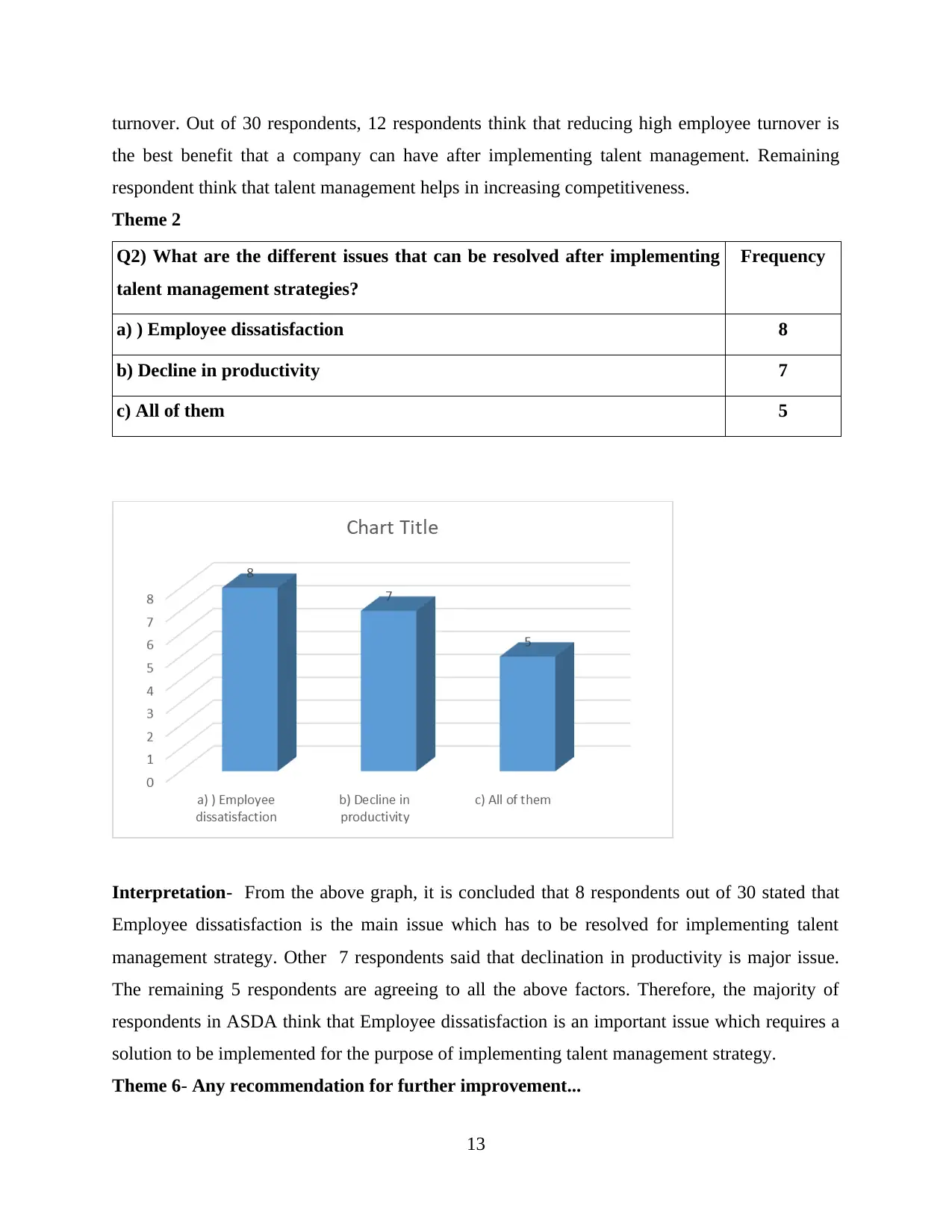
turnover. Out of 30 respondents, 12 respondents think that reducing high employee turnover is
the best benefit that a company can have after implementing talent management. Remaining
respondent think that talent management helps in increasing competitiveness.
Theme 2
Q2) What are the different issues that can be resolved after implementing
talent management strategies?
Frequency
a) ) Employee dissatisfaction 8
b) Decline in productivity 7
c) All of them 5
Interpretation- From the above graph, it is concluded that 8 respondents out of 30 stated that
Employee dissatisfaction is the main issue which has to be resolved for implementing talent
management strategy. Other 7 respondents said that declination in productivity is major issue.
The remaining 5 respondents are agreeing to all the above factors. Therefore, the majority of
respondents in ASDA think that Employee dissatisfaction is an important issue which requires a
solution to be implemented for the purpose of implementing talent management strategy.
Theme 6- Any recommendation for further improvement...
13
the best benefit that a company can have after implementing talent management. Remaining
respondent think that talent management helps in increasing competitiveness.
Theme 2
Q2) What are the different issues that can be resolved after implementing
talent management strategies?
Frequency
a) ) Employee dissatisfaction 8
b) Decline in productivity 7
c) All of them 5
Interpretation- From the above graph, it is concluded that 8 respondents out of 30 stated that
Employee dissatisfaction is the main issue which has to be resolved for implementing talent
management strategy. Other 7 respondents said that declination in productivity is major issue.
The remaining 5 respondents are agreeing to all the above factors. Therefore, the majority of
respondents in ASDA think that Employee dissatisfaction is an important issue which requires a
solution to be implemented for the purpose of implementing talent management strategy.
Theme 6- Any recommendation for further improvement...
13
Paraphrase This Document
Need a fresh take? Get an instant paraphrase of this document with our AI Paraphraser
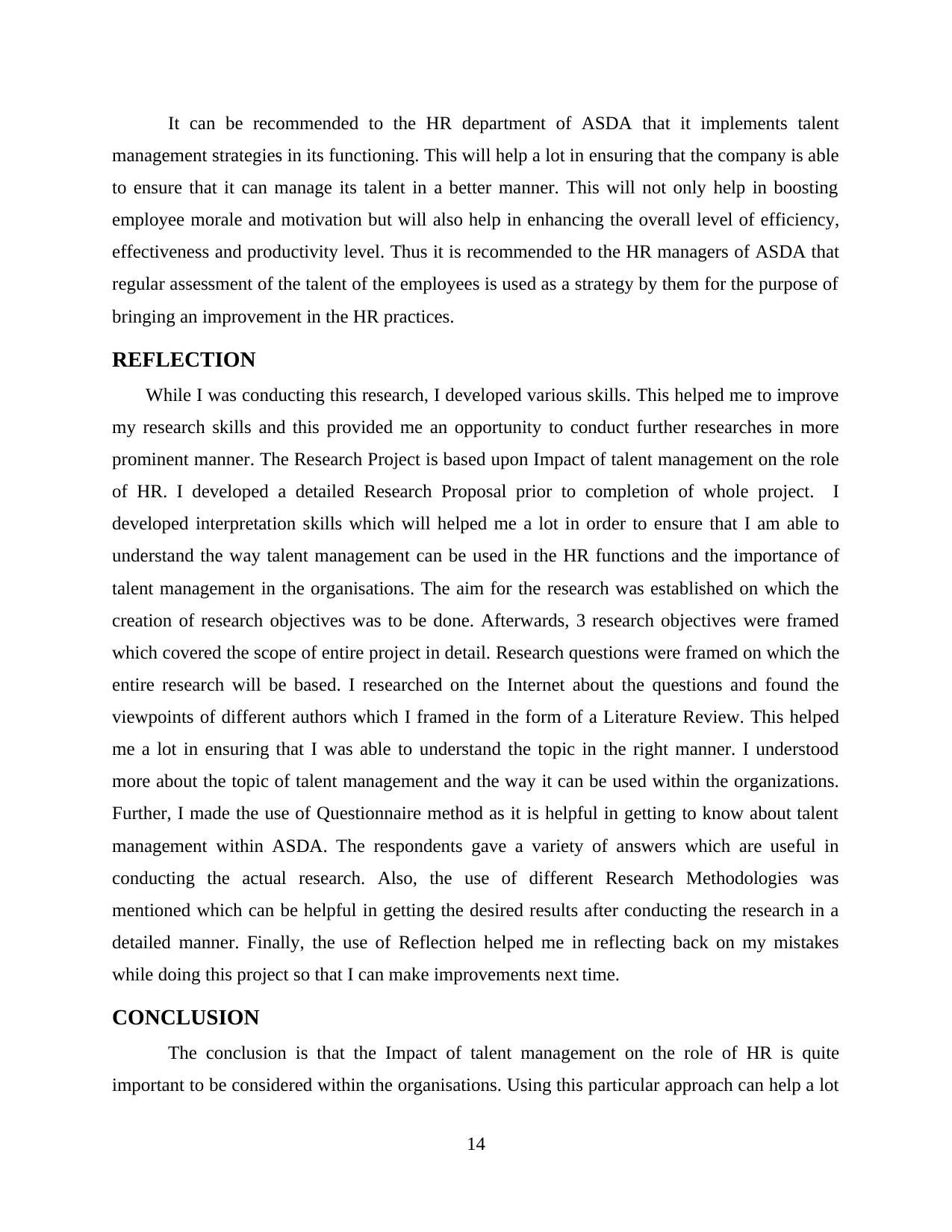
It can be recommended to the HR department of ASDA that it implements talent
management strategies in its functioning. This will help a lot in ensuring that the company is able
to ensure that it can manage its talent in a better manner. This will not only help in boosting
employee morale and motivation but will also help in enhancing the overall level of efficiency,
effectiveness and productivity level. Thus it is recommended to the HR managers of ASDA that
regular assessment of the talent of the employees is used as a strategy by them for the purpose of
bringing an improvement in the HR practices.
REFLECTION
While I was conducting this research, I developed various skills. This helped me to improve
my research skills and this provided me an opportunity to conduct further researches in more
prominent manner. The Research Project is based upon Impact of talent management on the role
of HR. I developed a detailed Research Proposal prior to completion of whole project. I
developed interpretation skills which will helped me a lot in order to ensure that I am able to
understand the way talent management can be used in the HR functions and the importance of
talent management in the organisations. The aim for the research was established on which the
creation of research objectives was to be done. Afterwards, 3 research objectives were framed
which covered the scope of entire project in detail. Research questions were framed on which the
entire research will be based. I researched on the Internet about the questions and found the
viewpoints of different authors which I framed in the form of a Literature Review. This helped
me a lot in ensuring that I was able to understand the topic in the right manner. I understood
more about the topic of talent management and the way it can be used within the organizations.
Further, I made the use of Questionnaire method as it is helpful in getting to know about talent
management within ASDA. The respondents gave a variety of answers which are useful in
conducting the actual research. Also, the use of different Research Methodologies was
mentioned which can be helpful in getting the desired results after conducting the research in a
detailed manner. Finally, the use of Reflection helped me in reflecting back on my mistakes
while doing this project so that I can make improvements next time.
CONCLUSION
The conclusion is that the Impact of talent management on the role of HR is quite
important to be considered within the organisations. Using this particular approach can help a lot
14
management strategies in its functioning. This will help a lot in ensuring that the company is able
to ensure that it can manage its talent in a better manner. This will not only help in boosting
employee morale and motivation but will also help in enhancing the overall level of efficiency,
effectiveness and productivity level. Thus it is recommended to the HR managers of ASDA that
regular assessment of the talent of the employees is used as a strategy by them for the purpose of
bringing an improvement in the HR practices.
REFLECTION
While I was conducting this research, I developed various skills. This helped me to improve
my research skills and this provided me an opportunity to conduct further researches in more
prominent manner. The Research Project is based upon Impact of talent management on the role
of HR. I developed a detailed Research Proposal prior to completion of whole project. I
developed interpretation skills which will helped me a lot in order to ensure that I am able to
understand the way talent management can be used in the HR functions and the importance of
talent management in the organisations. The aim for the research was established on which the
creation of research objectives was to be done. Afterwards, 3 research objectives were framed
which covered the scope of entire project in detail. Research questions were framed on which the
entire research will be based. I researched on the Internet about the questions and found the
viewpoints of different authors which I framed in the form of a Literature Review. This helped
me a lot in ensuring that I was able to understand the topic in the right manner. I understood
more about the topic of talent management and the way it can be used within the organizations.
Further, I made the use of Questionnaire method as it is helpful in getting to know about talent
management within ASDA. The respondents gave a variety of answers which are useful in
conducting the actual research. Also, the use of different Research Methodologies was
mentioned which can be helpful in getting the desired results after conducting the research in a
detailed manner. Finally, the use of Reflection helped me in reflecting back on my mistakes
while doing this project so that I can make improvements next time.
CONCLUSION
The conclusion is that the Impact of talent management on the role of HR is quite
important to be considered within the organisations. Using this particular approach can help a lot
14
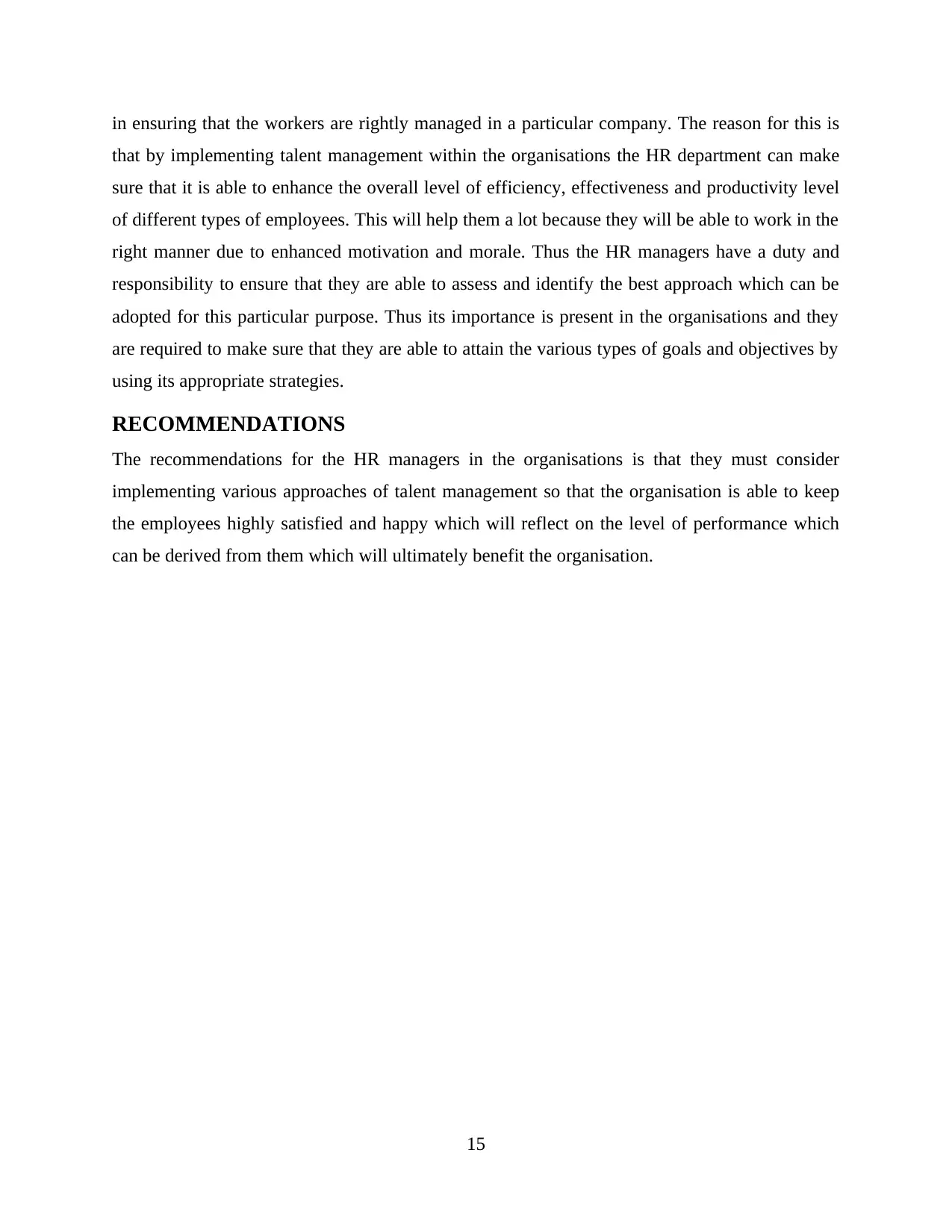
in ensuring that the workers are rightly managed in a particular company. The reason for this is
that by implementing talent management within the organisations the HR department can make
sure that it is able to enhance the overall level of efficiency, effectiveness and productivity level
of different types of employees. This will help them a lot because they will be able to work in the
right manner due to enhanced motivation and morale. Thus the HR managers have a duty and
responsibility to ensure that they are able to assess and identify the best approach which can be
adopted for this particular purpose. Thus its importance is present in the organisations and they
are required to make sure that they are able to attain the various types of goals and objectives by
using its appropriate strategies.
RECOMMENDATIONS
The recommendations for the HR managers in the organisations is that they must consider
implementing various approaches of talent management so that the organisation is able to keep
the employees highly satisfied and happy which will reflect on the level of performance which
can be derived from them which will ultimately benefit the organisation.
15
that by implementing talent management within the organisations the HR department can make
sure that it is able to enhance the overall level of efficiency, effectiveness and productivity level
of different types of employees. This will help them a lot because they will be able to work in the
right manner due to enhanced motivation and morale. Thus the HR managers have a duty and
responsibility to ensure that they are able to assess and identify the best approach which can be
adopted for this particular purpose. Thus its importance is present in the organisations and they
are required to make sure that they are able to attain the various types of goals and objectives by
using its appropriate strategies.
RECOMMENDATIONS
The recommendations for the HR managers in the organisations is that they must consider
implementing various approaches of talent management so that the organisation is able to keep
the employees highly satisfied and happy which will reflect on the level of performance which
can be derived from them which will ultimately benefit the organisation.
15
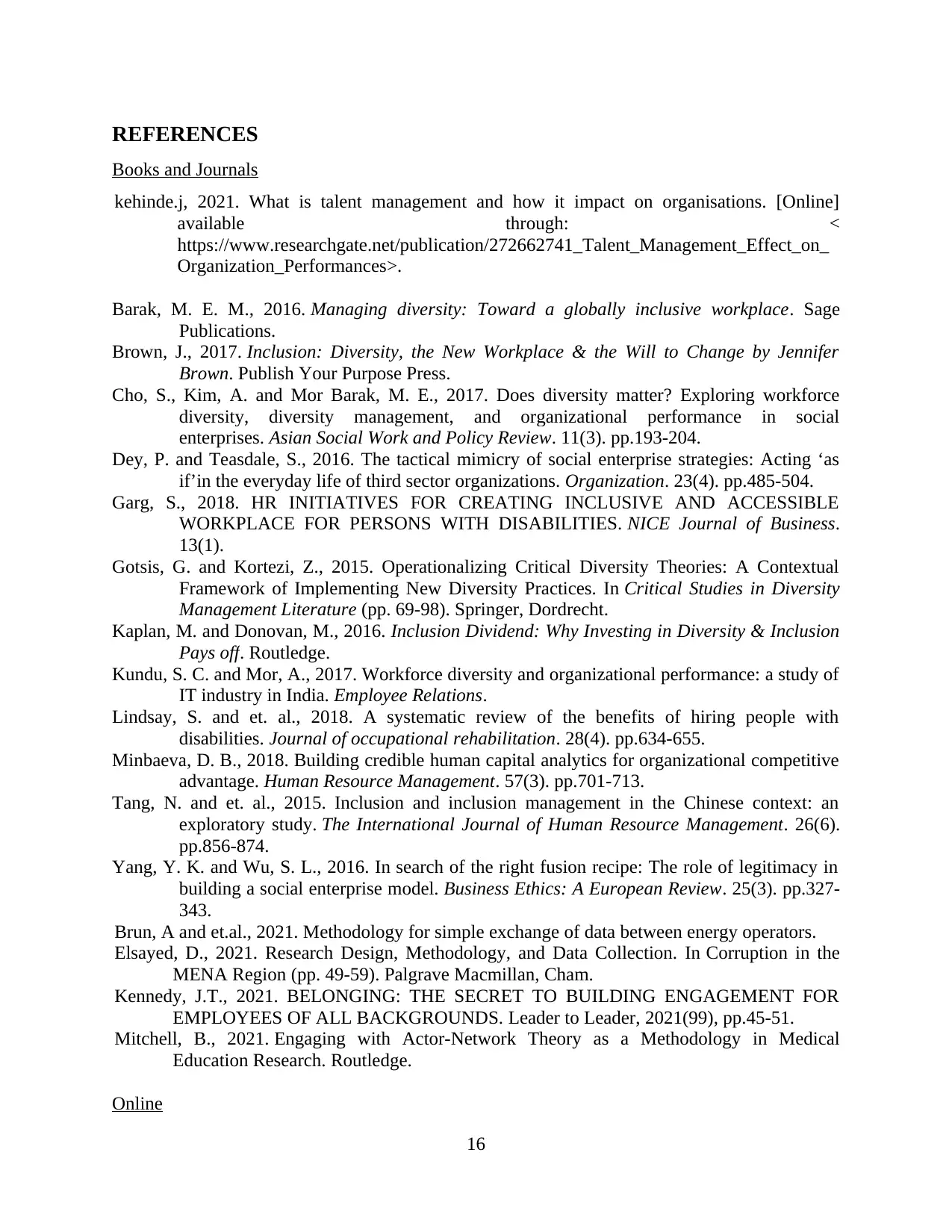
REFERENCES
Books and Journals
kehinde.j, 2021. What is talent management and how it impact on organisations. [Online]
available through: <
https://www.researchgate.net/publication/272662741_Talent_Management_Effect_on_
Organization_Performances>.
Barak, M. E. M., 2016. Managing diversity: Toward a globally inclusive workplace. Sage
Publications.
Brown, J., 2017. Inclusion: Diversity, the New Workplace & the Will to Change by Jennifer
Brown. Publish Your Purpose Press.
Cho, S., Kim, A. and Mor Barak, M. E., 2017. Does diversity matter? Exploring workforce
diversity, diversity management, and organizational performance in social
enterprises. Asian Social Work and Policy Review. 11(3). pp.193-204.
Dey, P. and Teasdale, S., 2016. The tactical mimicry of social enterprise strategies: Acting ‘as
if’in the everyday life of third sector organizations. Organization. 23(4). pp.485-504.
Garg, S., 2018. HR INITIATIVES FOR CREATING INCLUSIVE AND ACCESSIBLE
WORKPLACE FOR PERSONS WITH DISABILITIES. NICE Journal of Business.
13(1).
Gotsis, G. and Kortezi, Z., 2015. Operationalizing Critical Diversity Theories: A Contextual
Framework of Implementing New Diversity Practices. In Critical Studies in Diversity
Management Literature (pp. 69-98). Springer, Dordrecht.
Kaplan, M. and Donovan, M., 2016. Inclusion Dividend: Why Investing in Diversity & Inclusion
Pays off. Routledge.
Kundu, S. C. and Mor, A., 2017. Workforce diversity and organizational performance: a study of
IT industry in India. Employee Relations.
Lindsay, S. and et. al., 2018. A systematic review of the benefits of hiring people with
disabilities. Journal of occupational rehabilitation. 28(4). pp.634-655.
Minbaeva, D. B., 2018. Building credible human capital analytics for organizational competitive
advantage. Human Resource Management. 57(3). pp.701-713.
Tang, N. and et. al., 2015. Inclusion and inclusion management in the Chinese context: an
exploratory study. The International Journal of Human Resource Management. 26(6).
pp.856-874.
Yang, Y. K. and Wu, S. L., 2016. In search of the right fusion recipe: The role of legitimacy in
building a social enterprise model. Business Ethics: A European Review. 25(3). pp.327-
343.
Brun, A and et.al., 2021. Methodology for simple exchange of data between energy operators.
Elsayed, D., 2021. Research Design, Methodology, and Data Collection. In Corruption in the
MENA Region (pp. 49-59). Palgrave Macmillan, Cham.
Kennedy, J.T., 2021. BELONGING: THE SECRET TO BUILDING ENGAGEMENT FOR
EMPLOYEES OF ALL BACKGROUNDS. Leader to Leader, 2021(99), pp.45-51.
Mitchell, B., 2021. Engaging with Actor-Network Theory as a Methodology in Medical
Education Research. Routledge.
Online
16
Books and Journals
kehinde.j, 2021. What is talent management and how it impact on organisations. [Online]
available through: <
https://www.researchgate.net/publication/272662741_Talent_Management_Effect_on_
Organization_Performances>.
Barak, M. E. M., 2016. Managing diversity: Toward a globally inclusive workplace. Sage
Publications.
Brown, J., 2017. Inclusion: Diversity, the New Workplace & the Will to Change by Jennifer
Brown. Publish Your Purpose Press.
Cho, S., Kim, A. and Mor Barak, M. E., 2017. Does diversity matter? Exploring workforce
diversity, diversity management, and organizational performance in social
enterprises. Asian Social Work and Policy Review. 11(3). pp.193-204.
Dey, P. and Teasdale, S., 2016. The tactical mimicry of social enterprise strategies: Acting ‘as
if’in the everyday life of third sector organizations. Organization. 23(4). pp.485-504.
Garg, S., 2018. HR INITIATIVES FOR CREATING INCLUSIVE AND ACCESSIBLE
WORKPLACE FOR PERSONS WITH DISABILITIES. NICE Journal of Business.
13(1).
Gotsis, G. and Kortezi, Z., 2015. Operationalizing Critical Diversity Theories: A Contextual
Framework of Implementing New Diversity Practices. In Critical Studies in Diversity
Management Literature (pp. 69-98). Springer, Dordrecht.
Kaplan, M. and Donovan, M., 2016. Inclusion Dividend: Why Investing in Diversity & Inclusion
Pays off. Routledge.
Kundu, S. C. and Mor, A., 2017. Workforce diversity and organizational performance: a study of
IT industry in India. Employee Relations.
Lindsay, S. and et. al., 2018. A systematic review of the benefits of hiring people with
disabilities. Journal of occupational rehabilitation. 28(4). pp.634-655.
Minbaeva, D. B., 2018. Building credible human capital analytics for organizational competitive
advantage. Human Resource Management. 57(3). pp.701-713.
Tang, N. and et. al., 2015. Inclusion and inclusion management in the Chinese context: an
exploratory study. The International Journal of Human Resource Management. 26(6).
pp.856-874.
Yang, Y. K. and Wu, S. L., 2016. In search of the right fusion recipe: The role of legitimacy in
building a social enterprise model. Business Ethics: A European Review. 25(3). pp.327-
343.
Brun, A and et.al., 2021. Methodology for simple exchange of data between energy operators.
Elsayed, D., 2021. Research Design, Methodology, and Data Collection. In Corruption in the
MENA Region (pp. 49-59). Palgrave Macmillan, Cham.
Kennedy, J.T., 2021. BELONGING: THE SECRET TO BUILDING ENGAGEMENT FOR
EMPLOYEES OF ALL BACKGROUNDS. Leader to Leader, 2021(99), pp.45-51.
Mitchell, B., 2021. Engaging with Actor-Network Theory as a Methodology in Medical
Education Research. Routledge.
Online
16
Secure Best Marks with AI Grader
Need help grading? Try our AI Grader for instant feedback on your assignments.

Work Breakdown Structure. 2020. [Online]. Available through:
<https://www.tutorialspoint.com/management_concepts/work_breakdown_structure.ht
m>.
17
<https://www.tutorialspoint.com/management_concepts/work_breakdown_structure.ht
m>.
17

18
1 out of 18
Related Documents
Your All-in-One AI-Powered Toolkit for Academic Success.
+13062052269
info@desklib.com
Available 24*7 on WhatsApp / Email
![[object Object]](/_next/static/media/star-bottom.7253800d.svg)
Unlock your academic potential
© 2024 | Zucol Services PVT LTD | All rights reserved.





